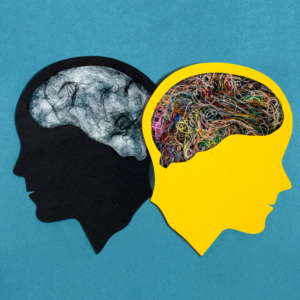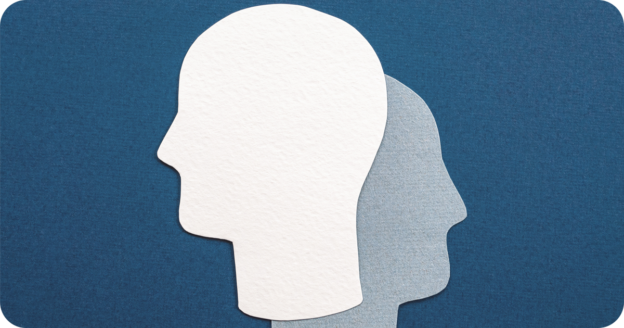Dual Diagnosis FAQs
Below are the top ten most frequently asked questions about dual diagnosis. The recovery process may seem complicated at first, perhaps even scary, especially if you or a loved one are seeking treatment while facing a dual diagnosis. Here are the facts, so you can understand the science and feel more comfortable dealing with your own dual diagnoses.
What Is a Dual Diagnosis?
When you have two diagnosed disorders at the same time, this is known as having a dual diagnosis. Defined by the National Library of Medicine “as co-occurring substance related and mental disorders” under the term Co-Occurring Disorder Hryb, K., Kirkhart, R., & Talbert, R. (2007). A call for standardized definition of dual diagnosis. Psychiatry (Edgmont (Pa. : Township)), 4(9), 15–16. Retrieved April 19, 2022, from https://www.ncbi.nlm.nih.gov/pmc/articles/PMC2880934/a dual diagnosis involves having both substance abuse disorder and a psychiatric disorder.
Dual diagnosis may actually be too specific of a term in some cases, as many people might have more than just two disorders—such as abusing multiple varieties of drugs at once or having multiple, separate psychiatric disorders. Physical disorders can also be quite common, along with other life factors that can contribute to the overall complexity of the diagnosis. Dual diagnosis. Dual Diagnosis – an overview | ScienceDirect Topics. (n.d.). Retrieved April 19, 2022, from https://www.sciencedirect.com/topics/medicine-and-dentistry/dual-diagnosis
However, for the purposes of this article, we will continue calling it a “dual diagnosis” for simplicity’s sake. Just keep in mind that some situations will also apply to people with three or more diagnosable disorders; others may only apply to those individuals.
“Substance abuse dual diagnoses are so common, in fact, that a study revealed the rates of a substance abuse disorder were less common among the general populace than among patients with other disorders.”
How Common Is Dual Diagnosis?

Depending on the type of disorder first discovered, a dual diagnosis might be extremely common. Among individuals addicted to cannabis, 75% of them have some sort of dual diagnosis, most often a mood or anxiety disorder. Brain and spinal cord injury cases are also very common, occurring anywhere from 15-70% of the time, depending on the factors involved during the initial diagnosis.
For schizophrenia diagnoses, 55% of patients have pre-existing substance abuse disorders, and 66% of patients with a substance abuse disorder also have a pre-existing psychiatric disorder as well.
Alcohol and drug disorders are especially commonplace in dual diagnosis scenarios, existing alongside disorders such as PTSD, clinical depression, and the use of other drugs. Alcohol and drug usage are heavily associated with psychiatric disorders, with the psychiatric disorder often existing first. Nicotine dependence is especially common in these scenarios. Kessler, R. C. (2004). The epidemiology of dual diagnosis. Biological Psychiatry, 56(10), 730–737. https://doi.org/10.1016/j.biopsych.2004.06.034
Substance abuse dual diagnoses are so common, in fact, that a study revealed the rates of a substance abuse disorder were less common among the general populace than among patients with other disorders. About half of these patients experienced an alcohol abuse disorder at some point in their lives. Substance use disorder also tended to be more common in patients who are young, male, single, and less educated. Drake, R., Mueser, K., (2000). Psychosocial Approaches to Dual Diagnosis, Schizophrenia Bulletin, 26(1), 105–118.https://doi.org/10.1093/oxfordjournals.schbul.a033429
What Causes Dual Diagnosis?
As mental health disorders often appear before a substance disorder does, it can be assumed that the struggle caused by mental health issues makes people more likely to turn to drugs and alcohol, creating a dual disorder and, later, a dual diagnosis. In the past, vulnerable people were frequently institutionalized before humanitarian efforts began in hopes to deinstitutionalize people with such disorders. Instead, they were often left to fend for themselves in poor living conditions that often involved danger from both gangs and drugs.
Being in such an environment only raises the odds of someone developing a drug abuse disorder. This psychosocial risk perspective theorizes that patients with a severe psychiatric disorder are more likely to engage in risk-taking behaviors, such as drugs and alcohol. Patients will often turn to mind-altering substances in order to try and cope with stress and trauma due to a lack of better solutions and resources. Drake, R. E., & Wallach, M. A. (2000). Dual diagnosis: 15 years of progress. Psychiatric Services, 51(9), 1126–1129. https://doi.org/10.1176/appi.ps.51.9.1126 These factors all explain why the combination of mental disorders and substance abuse disorders is so common.
What Challenges Are Associated with Dual Diagnosis?
For years, mental health treatment and drug addiction recovery were considered to be two separate issues with very separate treatment processes. People who had two or more disorders diagnosed would be encouraged to deal with them separately, often needing to treat one before seeking treatment for the other.
To do so, they would need to seek care at two different facilities, putting the burden of integrated treatment on the patient, rather than medical professionals. In the worst-case scenario, these patients would be excluded from getting treatment entirely, making it impossible to find a solution.
Even with the rise of integrated treatments, however, it might still be a bumpy ride to recovery. Substance abuse disorders are lifelong, necessitating constant vigilance, even after people have begun recovery. As people advance in recovery, their existing dual diagnosis may continue to create stress and risk a potential relapse.
Women often face extra stigma when it comes to dual diagnoses. Because dependency and its accompanying struggles are often viewed more harshly when the sufferer is a woman, sex and gender-based perspectives for treatment can be helpful.

There isn’t clear data on how many women suffer from a dual diagnosis compared to the documented rates for men, and those who do get diagnosed often face sexism from society as a result of gender stereotypes and norms. Women may even fear gendered violence, the loss of children, or sexual abuse, preventing many from seeking help in the first place. Torrens-Melich, M., Orengo, T., Rodríguez de Fonseca, F., Almodóvar, I., Baquero, A. Benito, A. (2021). Gender perspective in dual diagnosis. Brain Sciences, 11(8), 1101.https://doi.org/10.3390/brainsci11081101
Proper treatment is also more complicated for the homeless population. These individuals experience dual diagnoses of a psychiatric disorder and a substance abuse disorder almost 20% of the time. Lack of housing and the stigmas associated with being homeless can decrease their chances of obtaining treatment. Drake, R. E., Osher, F. C. Wallach, M. A. (1991). Homelessness and dual diagnosis. American Psychologist, 46(11), 1149–1158.https://doi.org/10.1037/0003-066x.46.11.1149
“Simply put, regular mental health treatment that isn’t designed to account for substance abuse disorders cannot address both facets of the individual’s struggles.”
How Is Dual Diagnosis Different from Other Disorders?
In the case of substance abuse disorders, drugs and/or alcohol often impact the severity of the mental health disorder. In order to properly treat both disorders, combined treatment is needed to combat both the mental disorder as well as the substance abuse disorder. Drugs and alcohol are often associated with mental health issues, and ignoring those dependencies will only increase the odds of more issues popping up down the line.
Alcoholism, for example, often contributes to the development of a depressive disorder. [fn] Woody G. (1996). The Challenge of Dual Diagnosis. Alcohol health and research world, 20(2), 76–80. Retrieved April 19, 2022, from https://www.ncbi.nlm.nih.gov/pmc/articles/PMC6876494/[/fn] Meanwhile, the depressive disorder can increase the individual’s desire to drink to deal with their depression. Simply put, regular mental health treatment that isn’t designed to account for substance abuse disorders cannot address both facets of the individual’s struggles.
Why Can’t I Just Treat My Dependency?
Much like only treating the mental health disorder, treating the addiction alone doesn’t solve the problem. As discussed earlier, psychiatric disorders increase the risk of using and becoming addicted to drugs and alcohol, and relapses are unfortunately very common. For example, a study of male veterans with alcohol addiction showed that higher rates of depression correlated to higher rates of relapse after treatment. [fn] Curran, G. M., Flynn, H. A., Kirchner, J. A., Booth, B. M. (2000). Depression after alcohol treatment as a risk factor for relapse among male veterans. Journal of Substance Abuse Treatment, 19(3), 259–265. https://doi.org/10.1016/s0740-5472(00)00107-0[/fn]
Treating your addiction without treating the other factors contributing to the struggle will likely only work temporarily. Dependency doesn’t happen in a vacuum. It’s best to get an integrated treatment for all the disorders you’re struggling with from certified mental health and substance use disorder professionals.
How Do I Know if My Loved One Has a Co-Occurring Disorder?
As with any medical disorder, the average person is at risk of misdiagnosis if they attempt to diagnose someone with no medical background. However, if you are worried your loved one may have a co-occurring disorder, you can start by exploring the symptoms of the potential disorders and considering how they may interact. You can’t know for sure unless your loved one seeks a proper diagnosis, but you can do your research ahead of time and speak with a doctor about your concerns.
What Does a Dual Diagnosis Worker Do?
Dual diagnosis treatment is a varied and complicated field, often based on the patient and individualized needs. New treatments are always emerging and being tested. However, there are some common practices shared by workers.
Dual diagnosis treatments are often developed within pre-existing mental health programs designed to help outpatients. Adding a substance abuse treatment plan to an already-designed mental health care plan is more feasible than the alternative of reproducing the other treatments in a substance abuse program.

They also aid patients by providing close resources and monitoring, use a long-term model under the expectation of recovery taking a few years to complete, and offer motivational interventions to convince people to keep going with the treatment. These measures all account for the difficulties associated with both substance abuse treatment and mental health treatment, allowing for a more accurate treatment plan that can cover multiple bases and doesn’t require keeping patients under constant hospital care.
Is Dual Diagnosis Treatment Effective?
Integrated treatments have proven to be more effective than non-integrated treatments are, despite the complications and costs associated with them. Due to the more complicated nature of these co-occurring disorders, a more specialized treatment is needed to help patients recover. The results of these treatments show promise.

In an integrated model designed to treat schizophrenic patients, group therapy includes both a mental health psychiatrist and an addiction counselor. Research suggests that such a model is more helpful than treating both disorders separately. Solomon, J., Zimberg, S., Shollar, E. (1993). Developing Dual Diagnosis Treatment Services within Existing Outpatient Psychiatric and Addictive Disorder Programs. In Dual diagnosis: Evaluation, treatment, training and program development (p. 254). Retrieved April 19, 2022, from https://books.google.com/books?id=nyqSBgAAQBAJ&printsec=frontcover&source=gbs_ge_summary_r&cad=0#v=onepage&q&f=false If the mental health and substance abuse disorder treatments are coordinated and delivered in the same setting, the treatments are even more likely to be successful.
Where Can I Go to Get Treatment?
Start with your primary care physician if you feel you may be suffering another mental health issue. Survey individualized care plans that treat the whole person, including any other co-occurring disorders—not just substance dependency.
Even though a dual diagnosis can be frightening and confusing, you don’t have to suffer alone. There is hope for recovery, and with facts, resources, and treatment available, you have the tools at hand to succeed.

